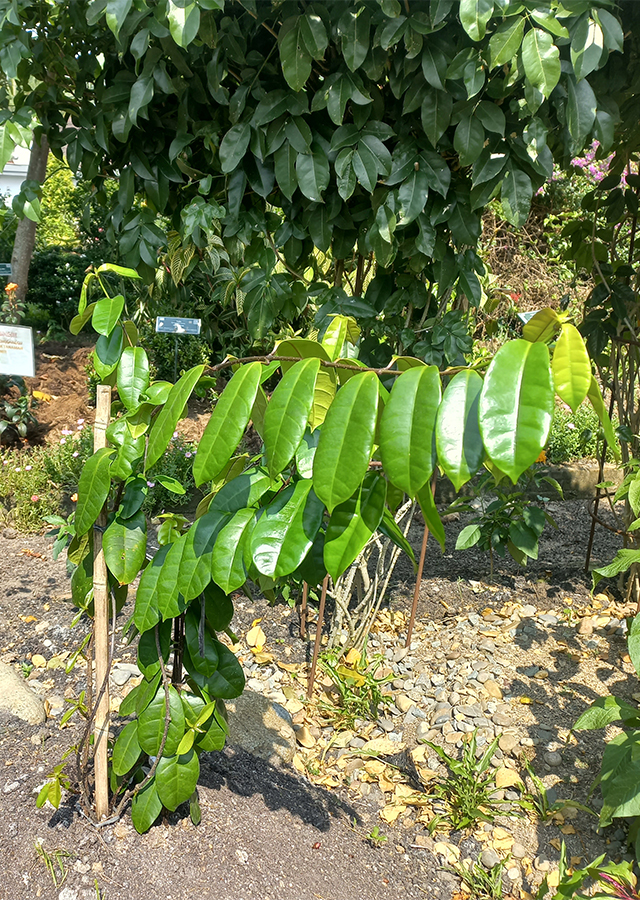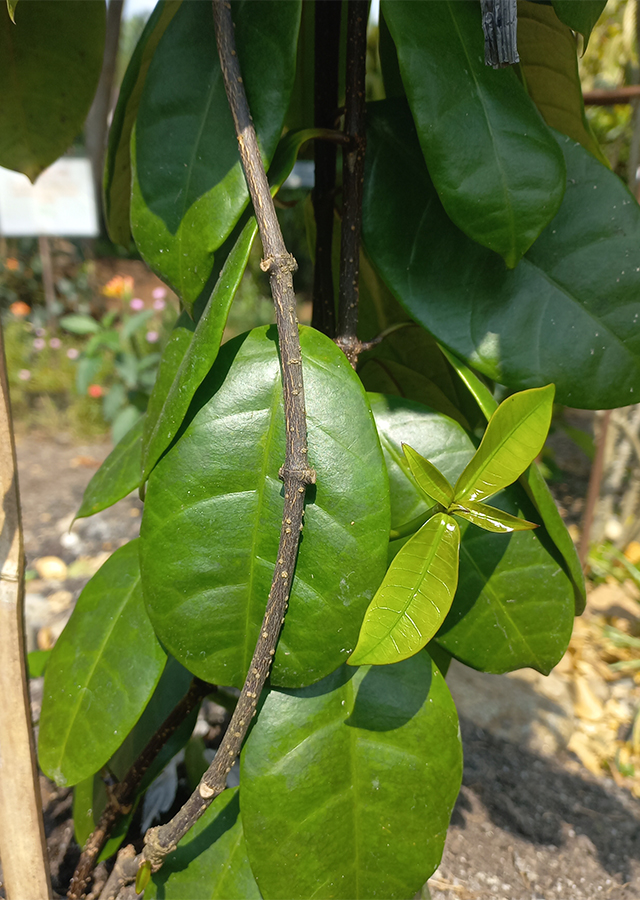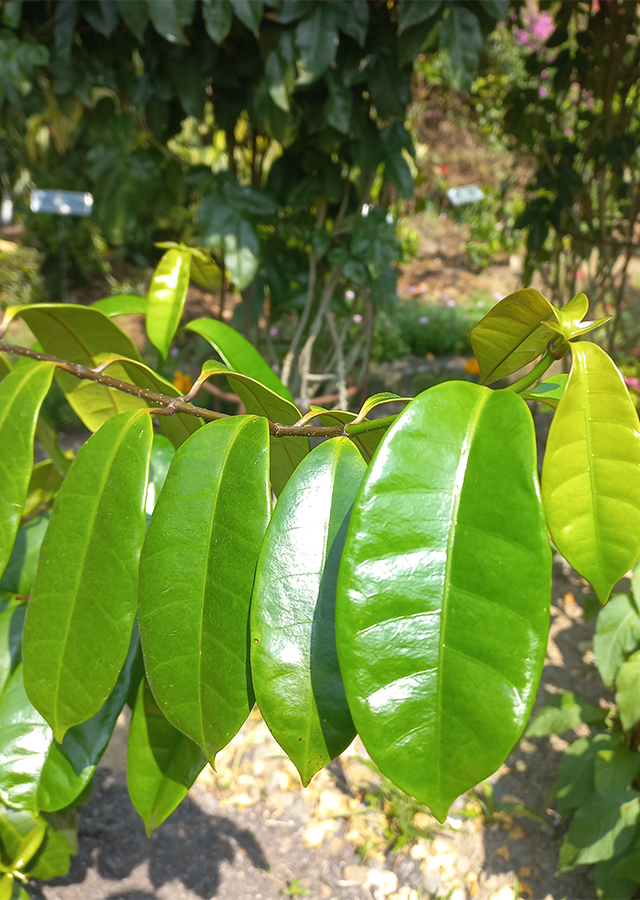Climbing Oleander
Strophanthus gratus (Wall. & Hook.) Baill.
Apocynaceae
Location in our garden
Principal



Synonym
Roupalia grata (Wall. & Hook.) T.Moore & Ayres
Strophanthus chopraie M.R.Almeida
Strophanthus gratus Franch.
Habitus
Climbers. A semideciduous, perennial climbing shrub that grows up to 25 m tall. Sometimes the plant grows more as a shrub 2-3 m tall and does not climb.
Part Used
Leaves
Bark
Roots
Stem
Growing Requirements
Full Sunshine
Habitat
Riverbanks
Forest
Overview
Strophantus gratus is native to West and Central Africa, from Senegal to Congo. It is cultivated for its medical and poisonous applications in Nigeria, Cameroon and Gabon. It is planted primarily for its ornamental value throughout South-East Asia, especially for its rose-scented blossoms. The plant is harvested from the wild for local use as a medicine. The seeds, stem bark and roots have been widely used to make an arrow poison.
Vernacular Names
Baan thon, Hom peenang, Yan peenang (Thailand).
Agroecology
Can be found in primary and secondary forests, often at forest margins and thickets from sea level to an altitude of 650 m. In Java, where it is cultivated, it grows well up to 1000 m altitude. Prefers to grow in full light in a fertile, moist but well-drained loam rich in organic matter and with additional leaf mould.
Morphology
- Stem - up to 10 cm in diameter, or less often a shrub, 2-3 m tall, branches dark or purplish brown, densely lenticellate, in older plants often with corky ridges.
- Leaves - ovate, obovate or elliptical, 5-18 cm × 2-9 cm, base rounded or cuneate, apex acuminate, petiole 5-32 mm long; cyme 3-32-flowered (1-6 flowers open at a time).
- Flowers - bisexual, fragrant, calyx with 10-20 colleters, sepals obovate to broadly obovate, glabrous; corolla tube 1.9-4.2 times as long as the calyx, white, turning yellow near the base outside, reddish or purple near the mouth outside, red- or purple-streaked inside, at the mouth 13-22 mm wide, corona lobes narrowly triangular or subulate, pink turning purple, corolla lobes orbicular or nearly so, 14-35 mm × 15-32 mm, white with a purple stripe outside turning reddish or purple all over, white and turning yellow inside, stamens 3-15 mm long, exserted.
- Fruit - follicles divergent at an angle of 180°, 23-41 cm × 3-4.3 cm, tapering towards the apex, ending in a narrow, obtuse tip.
- Seed - (9-)12-20 mm × 2.5-4.5 mm, beak glabrous for 6-15 mm and bearing a coma for (10-)23-47 mm, coma 83-102 mm long, spreading, erect or reflexed.
Cultivation
- Generative propagation is by seed.
- Vegetative propagation is by cuttings of young wood.
Chemical Constituents
Cardiac glycosides (ouabain), lignan pinoresinol, 8-hydroxypinoresinol, olivil, cardenolides.
Traditional Medicinal Uses
- The leaves are used in Africa as a folk medicine against snakebite.
- A leaf and stem decoction is taken in Sierra Leone and Côte d’Ivoire to treat gonorrhoea.
- In Ghana a decoction of bark is taken to treat weakness, and a leaf paste is applied to snakebites.
- In Côte d’Ivoire, Ghana and Nigeria a leaf paste is put onto sores, including guinea worm sores.
- In Nigeria a leaf infusion is taken to treat constipation, and is rubbed on the body to cure fever. A root decoction is said to be an aphrodisiac.
Part Used
Reference Sources
- Beentje, H.J. (No date). PROTA4U. Strophanthus gratus (Wall. & Hook.) Baill.. https://www.prota4u.org/database/protav8.asp?g=psk&p=Strophanthus%20gratus. 10-05-2022.
- Fern, Ken. (2021). Strophanthus gratus. http://tropical.theferns.info/viewtropical.php?id=Strophanthus+gratus. 10-05-2022.
- Hendrian, R. (2016). Strophanthus gratus (PROSEA). https://uses.plantnet-project.org/en/Strophanthus_gratus_(PROSEA). 10-05-2022.
- Kew Royal Botanic Gardens. (No date). Plants of the World Online: Strophanthus gratus (Wall. & Hook.) Baill. https://powo.science.kew.org/taxon/urn:lsid:ipni.org:names:81895-1. 10-05-2022.
- National Park of Singapore. (2021). Flora & Fauna Web: Strophanthus gratus. https://www.nparks.gov.sg/florafaunaweb/flora/2/4/2484. 10-05-2022.



